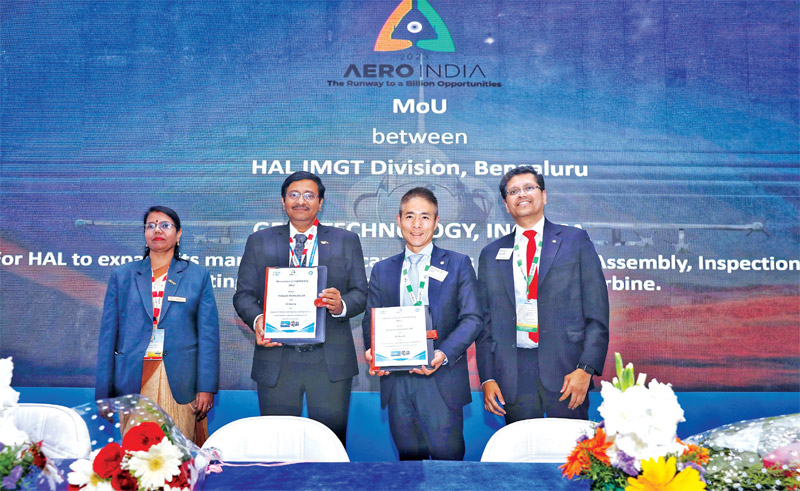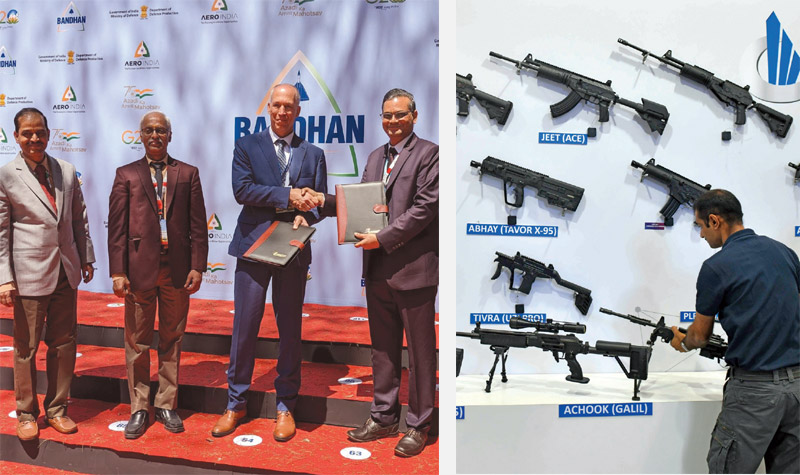Aatmanirbharta will remain pipedream as long as domestic defence industry takes shortcuts
 Ghazala Wahab
Ghazala Wahab
Those who have been passing off slogans as policies were not even done celebrating the masterstroke of Prime Minister Narendra Modi enabling ‘make in India’ of the GE 414 engines, when the French came up with a tantalising brew to ensure that the rave continues a bit longer.
According to a Hindustan Times report, written by someone with access to the top echelons of the government, Safran Aircraft Engine has got the clearance from the French government to jointly develop and produce a 110 kilo newton fighter engine in India, which will be able to power not just the DRDO’s under-development Advanced Medium Combat Aircraft (AMCA), but also the Indian Navy’s yet-to-be-developed twin-engine deck-based fighters (TEDBF).
There are a few interesting back details to the engine story. Stuck with the Kaveri engine, which refused to take off even after two decades of development, the DRDO was on the lookout for a partner to help the engine fly. By 2017, it was in talks with Safran Aircraft Engine, which had one-third share by value in the Rafale fighter, which Prime Minister Modi had bought off-the-shelf during his first visit to France. The talks started with the idea of seeking French help in the Kaveri engine and graduated to a possible joint venture between Safran Aircraft Engine and the DRDO. Safran offered to use its M-88 engine, which powers Indian Air Force’s Rafale, as the springboard for co-development of a new engine.
In a media interaction after his meeting with the DRDO chief, Chief Executive Officer, Safran Aircraft Engine, Olivier Andries said, “We are discussing all possibilities… starting point for development of a new engine could be the M-88 which powers Rafale fighter aircraft. We are proposing to help India develop complete capability to manufacture combat engines. This cooperation will not be programme or platform specific. Rather it will give India autonomy in combat engines.” Basically, what Safran was offering was more than hand-holding; it proposed to walk the DRDO across the technology curve, for a price.
But the DRDO was stuck on Kaveri. Hence, talks with Safran didn’t go the distance and reached a dead-end on the issue of the price Safran asked for cooperation. Kaveri eventually turned into a technology demonstrator and, according to some media reports, a derivative of it will be tested on unmanned aerial vehicle, Ghatak, currently under-development.
The new French offer, according to the report, is ‘extremely competitive’ and comes with several sweeteners including ‘100 per cent technology transfer’. Interestingly, if the French are proposing to ‘jointly design, develop, test, manufacture and finally certify an engine,’ as the report says, then what does technology transfer even mean? Won’t India own the jointly designed and developed technology? The answer perhaps lies in another interesting detail mentioned in the same report–‘Safran is already working on a 125 KN engine for the French next generation fighter’. So perhaps, the starting point will be the fighter engine already under development, hence the sweetener of ToT. The same is true for the GE MoU with the Hindustan Aeronautics Ltd (HAL)—the already operational 414 engine would merely be assembled in India.
None of this, neither the US nor the French offer, will lead to real ‘aatmanirbharta’ as is being projected by government cheerleaders inside the government and the media. The reason for this is simple. Through its journey, from self-reliance to make in India to aatmanirbharta, the slogan never translated into a meaningful, pragmatic and far-sighted policy. Indian defence industry has been ‘making’ in India for decades–from anti-tank guided missiles and tanks to submarines and fighter aircraft– yet none of this has led to a knowledge or technology base in the country. Because no real technology was sought nor transferred. And no Indian R&D organisations or manufacturing units could reverse engineer the systems or platforms they were making in India.
At the same media interaction in 2017 mentioned earlier, Andries alluded to the Vikas and Shakti engines, both of which are a result of Safran’s partnership and transfer of technology to the Indian Space Research Organisation (ISRO) and HAL. “We transferred this technology to India many decades ago,” Andries said. Both Vikas and Shakti engine continue to be used by the ISRO and HAL. Despite decades of manufacturing them, the acquired learning has not led to the development of a new engine type in India.

When Prime Minister Modi came to power in 2014, he did two things to give a push to the indigenous defence industry. He renamed the Defence Procurement Procedure (DPP) as the Defence Acquisition Policy (DAP), as if the fault was in the name. And the slogan of ‘self-reliance’, coined in 2001 after the bitter experience of the Kargil war, was replaced by ‘Make in India’. After his 2019 election victory, ‘Make in India’ was renamed as ‘Aatmanirbhar Bharat’, which actually is the Hindi translation of self-reliance. This was not only going back in time linguistically, but an admission that the Indian military industrial complex was spot running!
Building of a defence industry is as much a matter of ability as it is about political determination. As early as the 1960s, the People’s Republic of China understood that science had to be harnessed both for the nation’s defence and the welfare of the people. It modelled its Academy of Sciences on the Soviet system and sent its scientists in hordes to the Soviet Union to study and train.
When relations with the US got better, the Chinese government started sponsoring its students to study in the US, primarily in technologies that had military purposes as well. According to recent statistics, nearly 3,00,000 Chinese students study STEM subjects in US universities, forming the largest foreign student community in the world. Interestingly, according to the Chinese media, nearly 90 per cent of these return home after working in the US laboratories and companies for a few years. No wonder, as reported by The New York Times in 2020, there are concerns that these scientists and engineers carry their research work, including sensitive technologies, with them. In 2019, federal agencies started an investigation into China’s Thousand Talents recruitment programme, which was drawing not only Chinese scientists back to the homeland, but also US scientists by offering huge grants for their research projects in Chinese universities.
As a result of these multi-pronged, sustained efforts, China is now regarded as a military threat by the US. Such is Beijing’s growing military-technology capability that the US is creating a coalition of nations in the form of the Quad, Aukus, in addition to Nato, to contain China. Incidentally, China is also among the top five military equipment exporting countries behind the US, Russia and France.
In contrast, India’s journey towards self-reliance has been afflicted by indecisiveness, over-confidence, harbouring of mediocrity and unaccountability. A few years ago, a Russian specialist with one of the biggest defence companies, told me that the Russian government had offered India a few seats for the DRDO’s mid-level scientists in its laboratories. In response, the government of India offered to convert this proposal into an exchange programme between the two countries. Russia declined.
Driven by an exaggerated sense of national pride, Indian policymakers prefer shortcut procurements, instead of long-term investments in design and development, which run the risk of failure. Consequently, the DRDO favours off-the-shelf purchase of critical components and technologies and puts them together as indigenous systems. Indian industry tom-toms these instances of assembling as indigenisation citing the example of the interdependent global defence industry where it is common to buy components for one platform from specialist manufacturers, including those from outside the country.
This argument misses one important point. When Boeing as the manufacturer of the fighter plane Super Hornet buys engines from GE and missiles from Raytheon, it’s a collaboration of three expert US companies on a platform, each with stakes in it. This is not the case when HAL pays hard currency to import engines from a British, French or American company. All nations with credible military force have the capability to produce their own weapon systems; they resort to importing components only for commercial reasons, and mostly for the export of their platforms.

This kind of short-circuiting not only impacts India’s defence industrial capacity building, but also disincentivises research. The much-touted iDEX scheme, aimed at incubating and nurturing technologies by young scientists and start-ups, remains sub-par because of inadequate funding or outright purchase of nascent technology by the DRDO, which not only takes away the credit from young people but also kills their enthusiasm.
Obsessed with keeping the military out of policymaking loop to ensure that the civilian bureaucracy’s supremacy was not challenged, the government never realised the importance of indigenous defence industry. As long as the equipment was made in India, it was content that jobs were being created and government-owned companies were churning out materiel that was needed for the military, posting profit year on year based on the captive buyer—the Indian military. Whether these companies were developing capabilities to build new equipment based on emerging requirements of the military was immaterial. If the Indian military’s requirement changed, new weapon systems would be purchased, and a new ToT line would be started to keep the wheels of the government businesses running.
For example, the government-run Bharat Dynamics Ltd, started making the Milan anti tank guided missile (ATGM) on ToT from European company MBDA in the late 1970s. Today, BDL continues to produce the same missile, proudly listing it as its own in its portfolio, despite the fact that not only it does not hold the Intellectual Property Rights (IPR) of the technology, it also doesn’t have the capacity to use that learning to produce a new ATGM.
A measure of how much the government values indigenous research and development can be had from the defence budget 2023, in which only 10 per cent of the CapEx has been earmarked for R&D. The government also gave a sense of where this 10 per cent would be spent–in buying systems from global technology partners and manufacturing them in India through joint ventures. Today, almost all Indian defence R&D and manufacturing companies have a foreign technology partner. The resultant equipment is given an Indian name and proudly proclaimed as made in India in pursuance of ‘Aatmanirbhar Bharat.’ Essentially, the slogan is the policy.
But military power is not built on slogans.
If there was political determination to build the indigenous defence industry, the government of India would have sponsored Indian scientists to study abroad and nurtured them in Indian laboratories. It would have fixed accountability for state-owned defence research and manufacturing organisations, instead of running them as any other bureaucracy where competence and incompetence are treated alike, with job certitude and pension benefits. It would have disinvested substantially from state-run defence companies, allowing the private sector to buy stakes in them leading to a true private-public partnership. This would have ensured better efficiency, competitiveness and accountability. It would have instituted a long term, bipartisan fund for defence research, design and development. Most importantly, instead of projection, it would have focussed on achievable technologies.
Importance of Indigenisation
The primary purpose of any defence industry is to serve the nation’s armed forces. For this, the industry needs to work in close coordination with both the political dispensation and the military to stay in step with the anticipated threats as well as the means to mitigate or counter those threats. Only with this three-way cooperation can the industry produce what the military needs.
Defence exports, which are regarded as the touchstone of quality and competitiveness, are a by-product of the above coordination. Since national military requirements are finite and ever evolving, and weapon development process long and capital intensive, it’s impossible for industries to sustain themselves solely on the basis of domestic supply. That’s why, once the domestic requirements are met, similar technologies/ systems/ platforms etc are offered to global customers. One critical prerequisite for defence exports is induction or operationalisation of the equipment by the home military. That is the biggest advertising for any military product. The wars in Afghanistan and Iraq propelled the export of weapons systems successfully deployed in these theatres. After all, if your own military has little or no faith in the weapon systems produced by your industry, how can others trust it.
Here lies the truth about India’s military industrial complex. If India is the largest importer of military hardware worldwide, clearly Indian defence industry has been unable to meet the requirements of the Indian military. Domestic defence industry is critical for any nation’s military power for two reasons. One, it ensures independence of foreign policy; and two, it gives the nation the confidence to employ military force in national interest without worrying about sustaining such employment, because the domestic industry would step up production of ammunition and wherewithal to meet the military requirements. From World War II to the current Russia-Ukraine conflict, military campaigns have been sustained by a surge in production of defence equipment by the domestic industries.
Dependence on foreign military supplies restricts one’s foreign policy choices, and consequently the capacity to wage a military campaign. For instance, the US has put restrictions on Pakistan’ use of F-16 fighters against India. And uncertainty of US’ reliability on product support in case of a war comes in the way of India buy direct combat platforms from the US.
Two conflicts, separated by over two decades and united by a similar lack of military preparedness because of over-dependence on defence imports, underscore the importance of the domestic defence industry. In the summer of 2020, when Chinese troops sauntered into Ladakh and occupied up to 1,000 sq km of Indian territory, apart from the shock and awe, what paralysed the Indian government was the realisation that it was militarily unfit to take on the PLA. This forced the government of India to do two things.
One, it rushed into signing a joint statement with China in September 2020 in Moscow (mediated by Russia), which disproportionately favours Beijing. Two, it authorised emergency import of materiel worth Rs 5,000 crore in 2020 for the Indian military. Apart from weapons, this included creature comforts, such as insulated all-weather tents, high-altitude clothing and shoes for the troops deployed overnight in eastern Ladakh to resist further Chinese intrusions.
The summer of 2020 brought back memories of Pakistan’s intrusion in the Kargil sector of Ladakh in 1999, when the then Chief of the Army Staff, General V.P. Malik (retd) famously told the media that, “We will fight with whatever we have.” Even if the chief hadn’t spoken, the weapon exporting nations knew the truth of India’s defence preparedness as bureaucrats got busy either calling up friendly nations for emergency ammunition or flying out with suitcases to purchase spares in hard currency.
Time seems to have stood still in these two decades, as far as India’s defence preparedness and defence industry is concerned. It brings to mind, poet Shailendra’s words, “Hum hain wahin, hum the jahan (we are still where we used to be). Running on the treadmill.

